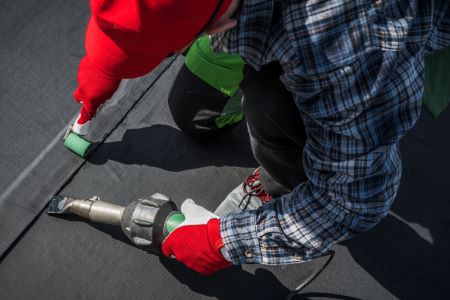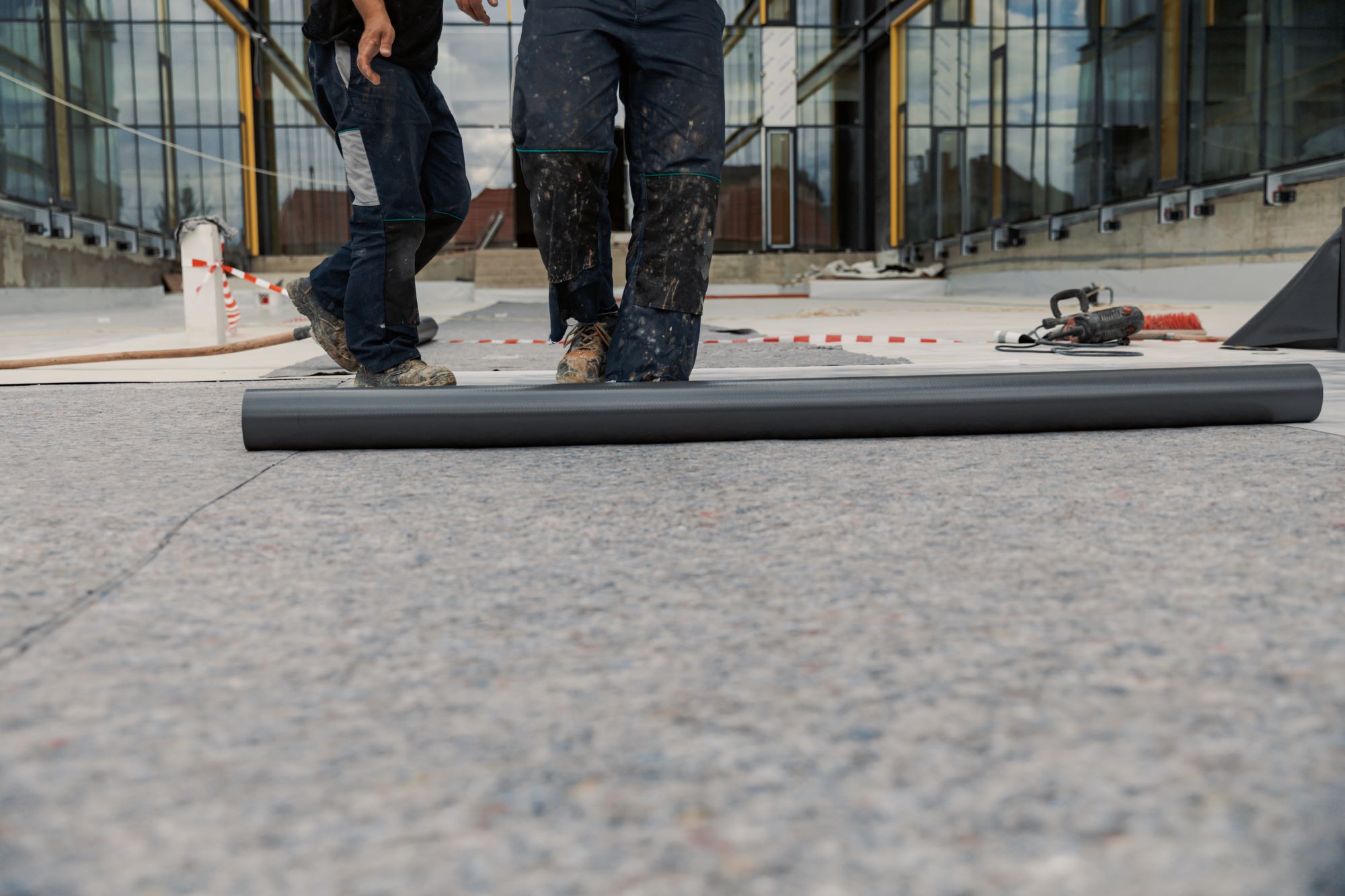The lifespan of a commercial roof is influenced by several factors, ranging from the type of commercial roofing materials used to the quality of commercial roof installation and the frequency of commercial roof repair. With the significant investment that a commercial roof represents, understanding the expected lifespan and factors affecting it can help business owners plan better for maintenance, repairs, and eventual replacement.
1. The Role of Commercial Roofing Materials:
There’s a wide variety of commercial roofing materials available, and each comes with its unique lifespan.
Built-Up Roofing (BUR): Made by layering tar paper and liquid asphalt, BUR systems have been around for decades. With proper installation and maintenance, these roofs can last between 20 to 30 years.
Metal Roofing: Highly durable metal roofs can last 40 to 60 years, depending on the metal used. Materials like copper and zinc can have even longer lifespans. However, they do require periodic inspections to check for corrosion or damages.
Thermoset (EPDM) Roof Membrane: EPDM roofs, known for their durability and simplicity, have a lifespan of about 20 to 30 years. Their resistance to UV rays, weather fluctuations, and certain chemicals make them a popular choice.
Thermoplastic (PVC & TPO) Roof Membranes: PVC and TPO roofs can last between 15 to 30 years. Factors like thickness, quality of installation, and exposure to harsh chemicals can influence their longevity.
Modified Bitumen Roofing: With a similar makeup to BUR but added with modern materials and application methods, these roofs can last 20 to 30 years.
Green Roofs: While green roofs offer environmental benefits, they are also quite durable. With proper maintenance, a green roof can last 30 to 50 years, thanks to the protective layer of vegetation that shields the waterproofing membrane.
Spray Polyurethane Foam (SPF) Roofing: SPF roofing can last over 30 years if properly maintained. Their longevity is due to their excellent insulation properties and resistance to water penetration.

2. Quality of Commercial Roof Installation:
The durability of a commercial roof isn’t solely based on materials. The expertise and technique with which it’s installed play a significant role in its longevity. An improperly installed roof can lead to a multitude of issues, such as pooling water, leaks, and premature aging. Engaging with experienced professionals ensures that the roof is adequately installed with proper drainage, flashing, and sealing, factors that can significantly extend a roof’s life.
3. Maintenance and Commercial Roof Repair:
Routine maintenance is paramount to the lifespan of any commercial roofing system. Commercial roofs are prone to wear and tear from environmental factors, structural movements, and other unforeseen challenges. Periodic inspections can help in detecting minor issues before they escalate into significant problems.
When damages or weak spots are detected early, commercial roof repair can address them promptly. This not only ensures the safety of the building’s occupants but also adds to the roof’s longevity. Neglected roofs, even if made from the highest-quality materials, will deteriorate faster than those that are regularly inspected and repaired.
4. Environmental Factors:
Environmental conditions also impact a roof’s longevity. For instance, roofs in areas with harsh winters and frequent snowfall might experience more wear and tear than those in temperate climates. Similarly, commercial roofs in coastal areas may deteriorate faster due to the salt in the air. It’s essential to choose commercial roofing materials that are best suited to a building’s geographic location and environmental conditions.
5. Additional Factors:
Other factors can influence the longevity of a commercial roof. For example, the building’s design can impact water drainage. Flat roofs might accumulate water if not adequately sloped or if drainage systems are not in place. Also, the quality of materials used, even within a particular category (like TPO or EPDM), can vary, affecting the roof’s lifespan.
Conclusion:
In essence, while commercial roofing materials provide a general guideline on expected longevity, the actual lifespan of a commercial roof is an interplay of installation quality, maintenance, repair, environmental conditions, and more. For those looking to install a new roof or assess the state of their existing structure, it’s advisable to engage professionals who can provide insights into the best materials for the local climate, ensure top-notch commercial roof installation, and offer timely commercial roof repair services. This holistic approach will ensure the longest possible life for a commercial roof, safeguarding the investment and ensuring the safety and security of the building’s occupants.
- Commercial Roof Installation Tampa FL
- Flat Roof Repair Tampa FL
- Commercial Roof Maintenance Tampa FL
- Commercial Roofing Contractors Tampa FL
- Commercial Emergency Roof Service Tampa FL
- Commercial Roof Repair Tampa FL
- Roof Coating Company Tampa FL
- Flat Roof Replacement Tampa FL
- Metal Roofing Contractors Tampa FL
- Commercial Roof Replacement Tampa FL
- Flat Roof Installation Tampa FL
- Commercial Roof Installation Asheville NC
- Commercial Roof Installation Orlando FL
- Flat Roof Repair Orlando FL
- Commercial Roof Maintenance Orlando FL
- Commercial Roofing Contractors Orlando FL
- Commercial Emergency Roof Service Orlando FL
- Commercial Roof Repair Orlando FL
- Roof Coating Company Orlando FL
- Flat Roof Replacement Orlando FL
- Metal Roofing Contractors Orlando FL
- Commercial Roof Replacement Orlando FL
- Flat Roof Installation Orlando FL
- Flat Roof Repair Asheville NC
- Commercial Roof Maintenance Asheville NC
- Commercial Roofing Contractors Asheville NC
- Commercial Roof Installation Jacksonville FL
- Commercial Roofing Contractors Jacksonville FL
- Commercial Roofing Contractors Atlanta GA
- Commercial Roofing Contractors Mobile AL
- Commercial Roof Installation Atlanta GA
- Commercial Roof Installation Mobile AL
- Flat Roof Repair Jacksonville FL
- Flat Roof Repair Atlanta GA
- Flat Roof Repair Mobile AL
- Commercial Roof Maintenance Jacksonville FL
- Commercial Roof Maintenance Atlanta GA
- Commercial Roof Maintenance Mobile AL
- Commercial Emergency Roof Service Asheville NC
- Commercial Emergency Roof Service Jacksonville FL
- Commercial Emergency Roof Service Atlanta GA
- Commercial Emergency Roof Service Mobile AL
- Commercial Roof Repair Asheville NC
- Commercial Roof Repair Jacksonville FL
- Commercial Roof Repair Atlanta GA
- Commercial Roof Repair Mobile AL
- Roof Coating Company Asheville NC
- Roof Coating Company Jacksonville FL
- Roof Coating Company Atlanta GA
- Roof Coating Company Mobile AL
- Flat Roof Replacement Asheville NC
- Flat Roof Replacement Jacksonville FL
- Flat Roof Replacement Atlanta GA
- Flat Roof Replacement Mobile AL
- Metal Roofing Contractors Asheville NC
- Metal Roofing Contractors Jacksonville FL
- Metal Roofing Contractors Atlanta GA
- Metal Roofing Contractors Mobile AL
- Commercial Roof Replacement Asheville NC
- Commercial Roof Replacement Jacksonville FL
- Commercial Roof Replacement Atlanta GA
- Commercial Roof Replacement Mobile AL
- Flat Roof Installation Asheville NC
- Flat Roof Installation Jacksonville FL
- Flat Roof Installation Atlanta GA
- Flat Roof Installation Mobile AL

